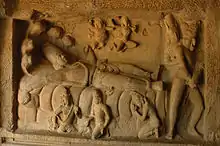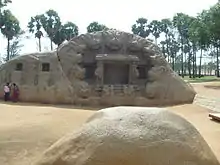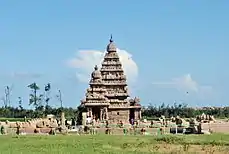Cave Temples of Mahabalipuram
The Cave Temples of Mahabalipuram are part of the Group of Monuments at Mahabalipuram, less well-known than the ratha temples.
.jpg.webp) Cave Temples of Mahabalipuram | |
 Shown within India | |
| Location | hyderabad |
|---|---|
| Coordinates | 12.6167°N 80.1917°E |
They are located on the hillock of the town, overlooking the Coromandel Coast of the Bay of Bengal in Kanchipuram District in Tamil Nadu, India. They are cut and decorated with panels in the Mamalla style of the Pallava period in the 7th century. They are differentiated from the Adiranchanda cave temples which are dated to the Mahendraverman period of the 8th century. Remnants seen in the caves also indicate that they were plastered and painted when built.[1] One of the most impressive sculpture panels, bas-reliefs, carved on the walls in the caves is that of the goddess Durga (a form of goddess Shakti) who killed Mahishasura the buffalo-headed demon which has a natural beauty with elegance of sense of movement.[2] Many of the caves of the Pallava period have remained incomplete. The procedure in creating these caves involved creation of a smooth rock face, then cutting columns through the polished rock faces of required size and then carving bas-reliefs on the walls of the cave.[3]
Geography
The site is in the Kanchipuram district, approximately 58 kilometres (36 mi) from Chennai city (previously, Madras) and about 20 miles (32 km) from Chingelpet.[4]
History
The caves reflect a transitional style architecture evolved during the rule of kings Mahendra Varman I and Rajasimha or Narasimhavarman I known as Mamalla and this style was continued by his son Parameshvaravarman I.[5] Historical research has also confirmed that Mahabalipuram town came to be established only after it was named after Mamalla and the caves and rathas are dated to his period during the year 650 AD.[6] That Mahabalipuram was a busy port and prosperous during Mamalla's rule is attested by the fact that Xuanzang, the Chinese traveller stayed here in 642 AD as a guest of the court recording the greatness of the town and its king. Thirumangai Alvar, a vaishnava saint of Tamil Nadu has also recorded glowingly about the town's richness as seen from the loaded ships exporting goods. The caves excavated during this period though similar to the earlier caves but were more sophisticated in their decorations. The Varaha Cave temple or Mandapa has fluted columns separating the openings. Certain Greco-Roman architectural styles could also be discerned and the sitting statues are said to have likeness to the sitting styles seen in European architecture, as against the Indian cross legged style. The style thus created at Mahabalipuram became a forerunner for Dravidian style of architecture.[7] The Pallavas were great patrons of art.
Features
They have distinctive styles which do not compare with the Gupta period sculptures of North India. In these caves, the carvings of the faces of the human figures are oval shaped with high cheekbones. The body looks slim with tapering limbs. They have several striking mythological scenes carved in relief. Vishnu rescuing the earth, Vishnu taking three strides, and Gaja Laksmi and Durga are all in the Adi-Varaha Cave. Mahishasura Mardhini is in Durga Cave. Krishna lifting mountain is seen in the Pancha-Panadava cave. The relief carving in the Pallava caves is generally shallower than the Deccan caves. The main figures are slender, delicate and elegant. Their hair dresses and crowns are simple and they show no jewellery.[8] Another particular feature noted in the caves is that the lingas are individual carvings and in prismatic shape. However, the drainage as normally provided in the form of pranala or water chute with the linga to drain the abhisheka (Hindu ritual) offering water is not provided in the caves.[9]
Landmarks
Krishna
The Krishna Cave Temple is dated to mid-7th century. Its excavated entry is seen with columns leading to a hall. A notable carving inside the cave is a sculpted panel which brings out the myth of Krishna lifting the Govaradhan hill to protect the cow herds and gopis (milk maids) from heavy rains and floods, and also scenes of Krishna frolicking with the milk maids.[10][11]
Mahishasuramardini

The Mahishasuramardini Cave Temple is close to the lighthouse on the top of the hill. It has two carved frescoes of Durga, the mother goddess at both ends of the long hall of the cave. She is shown seated on lion her mount or vehicle with all her weapons. The depiction also features her posture of slaying the buffalo headed Mahishasura. At the other end of the hall, opposite to the Durga panel, the scene carved is of Vishnu in a reclining posture on the bed of Ananta multi-hooded serpent. He is surrounded by the divine beings of heaven appealing him to continue with the creation of the universe. There is also a third chamber which shows a carved fresco of Vishnu.[10]
Varaha

The Varaha Cave Temple (also known as Adivaraha) is dated to the 7th century. The most prominent sculpture is that of Vishnu in the incarnation form of a boar lifting mother earth from the sea. Also carved are many mythical figures.[10] In the entry porch carved on the rock face the columns are carved on lion bases. At the centre of the rear wall, guardian figures are depicted flanking a shrine. The side walls have carved sculpture panels of Vishnu as Trivikrama and Vishnu in the incarnation of Varaha, the boar, lifting Bhudevi, the earth goddess.[12]
Trimurti
The Trimurti Cave Temple is dated to the early 8th century. It has separate sections in a sequenced dedicated to each of the Hindu trinity gods of Brahma, Vishnu and Shiva or Maheshwara. The three shrines are cut out from the rock-face. Each shrine is flanked by pilasters with guardian figures. On the rear wall of the cave, individual carvings of Brahma, Vishnu and Shiva attended by devotees are carved.[13]
Kotikal
The Kotikal Cave Temple is dedicated to goddess Durga. Its entrance faces west and is in continuation of the Dharmaraja Mandapa. The rock cut façade has two supporting pillars and two pilasters in Mahendravarman style of architecture with an octagonal shaft built over a cubical base, and a similar top. The cave chamber inside is 21.5 feet (6.6 m) long, 8 feet (2.4 m) wide and has a height of 8 feet (2.4 m). There is also a small chamber on the rear wall flanked by female dvarpalas (guards); the dvarapala on the left, facing to the front, is carved in a standing posture with one hand holding a club and the other hand holding a sword. The dvarapala on the right is carved with one hand holding a dhanush (bow) and the other arm is resting on her waist. The dvarpalas are in a dancing pose, called tribhanga (triple break). Though there is no deity inside this shrine now, it is conjectured that the sanctum inside housed goddess Durga with the female guardians protecting her at the entrance to the cell.[14]
Tiger

The Tiger Cave Temple (also known as Yali) is dated to the early 8th century. It is a shallow cave but is unusual and unique when compared to the other caves here. The entrance to the cave faces south-east. It is close to the Atiranachanda Mandapa and located at Saluvankuppam village, 4 kilometres (2.5 mi) to the north of Mamallapuram. This is a refined cave which is carved about 6 feet (1.8 m) above the ground level and has a pavilion which is closed on three sides. The front cavern is 6 feet (1.8 m) in height and has a width of 4 feet (1.2 m). Approach to the cavity is over a series of steps, and the protection parapets on either side of the staircase are decorated with lions. The two niches on either side of central cavity do not have any carvings. It has been carved out of a boulder with a portico which has sculpted garland of eleven yali heads, mythical animals in the shape of tigers. The main carving here is that of Durga riding a tiger. It is also inferred that this cave may have been used for holding open-air shows or as utsava mantapa (festival pavilion) for the festival of Indra. The lion pilasters carved at the corners of this cavity also show a female riding a ferocious looking lion, which is reported as the first of its kind in Mahabalipuram caves, and hence credited to the Pallava King Rajasimha; there is also a carving of its creator Rajasimha.[15][10][16]
Atiranachanda
The Atiranachanda Cave Temple is east facing. It is situated at Saluvankuppam village, about 4 kilometres (2.5 mi) away on the Mahabalipuram – Chennai road. Its layout is 28 feet (8.5 m)t in length and 6 feet (1.8 m) in width on plan, with a height of 6.5 feet (2.0 m). The façade carved on the rock face has two pillars and two pilasters, typical of Mahendravarman style, with an octagonal shaft with square base at the top and the bottom. The corbels of the pillars are curved and of roll-moldings. Horizontal friezes in the form of mini shrines are also carved above the corbels, though incomplete. There are three chambers in the cavern with the central chamber being a square of 3.5 feet (1.1 m), whereas the other cells are integral to the wall.[17]
Panchapandava
The Panchapandava Cave Temple is near the open air bas-relief of Arjuna's Penance. The cave entrance is east facing and is the largest cavern at 50 feet (15 m) length. The cave is unfinished. The length of the opening is indicative of creating a circumambulatory passage within the cave to go round the main shrine. At present only a small chamber has been carved at the center and has remained attached to the main rock. At the entrance, the curved cornice has a series of shrines with the four central shrines projecting out. The vaulted roofs of the shrines are carved with horse-shoe (kudu) shaped windows and each houses another smaller shrine. The niche below the kudu has a carved deity. Ferocious looking lions are also carved. From the architectural features carved here it is conjectured that this style could be assigned to Narasimhavarman I Mamalla period extending to Narasimhavarman II Rajasimha period.[18]
References
- "World Heritage Sites – Mahabalipuram, Group of Monuments Mahabalipuram (1984), Tamil Nadu". Archaeological Survey of India. Retrieved 23 October 2012.
- "Durga Temple (Mahishasuramardini Cave Temple, Mamallapuram)". Online Gallery of British Library. Retrieved 23 October 2012.
- George Michell (1977). The Hindu Temple: An Introduction to Its Meaning and Forms. University of Chicago Press. pp. 81–. ISBN 978-0-226-53230-1. Retrieved 7 February 2013.
- Ayyar, P. V. Jagadisa (1982). South Indian Shrines: Illustrated. Asian Educational Services. pp. 157–. ISBN 978-81-206-0151-2. Retrieved 7 February 2013.
- G. Jouveau-Dubreuil (1 December 1994). Pallava Antiquities – 2 Vols. Asian Educational Services. pp. 30–. ISBN 978-81-206-0571-8. Retrieved 3 January 2013.
- Trudy Ring; Robert M. Salkin; Sharon La Boda (1995). Asia and Oceania: International Dictionary of Historic Places. Taylor & Francis. pp. 912–. ISBN 978-1-884964-04-6. Retrieved 7 February 2013.
- Trudy Ring; Noelle Watson; Paul Schellinger (12 November 2012). Asia and Oceania: International Dictionary of Historic Places. Taylor & Francis. pp. 554–555, 912–. ISBN 978-1-884964-04-6. Retrieved 3 January 2013.
- Upinder Singh (1 September 2008). A History of Ancient and Early Medieval India: From the Stone Age to the 12th Century. Pearson Education India. pp. 634–. ISBN 978-81-317-1120-0. Retrieved 7 February 2013.
- Rajeshwari Ghose (1 January 1996). The Lord of Ārūr: The Tyāgarāja Cult in Tamilnāḍu : a Study in Conflict and Accommodation. Motilal Banarsidass. pp. 36–. ISBN 978-81-208-1391-5. Retrieved 7 February 2013.
- Pippa de Bruyn; Keith Bain; David Allardice; Shonar Joshi (18 February 2010). Frommer's India. John Wiley & Sons. pp. 750–. ISBN 978-0-470-64580-2. Retrieved 7 February 2013.
- "General view of the entrance to the Krishna Mandapa, Mamallapuram". Online Gallery of British Library. Retrieved 22 February 2013.
- "General view of the entrance to the Varaha Cave Temple, Mamallapuram 10032213". Online Gallery of British Library. Retrieved 22 February 2013.
- "Entrance, with rock-cut sculptures, to the Trimurti Cave Temple, Mamallapuram". Online Gallery of British Library. Retrieved 22 February 2013.
- "Mahabalipuram – The Workshop of Pallavas – Part II". puratattva.in. Art-and-archaeology.com. 4 August 2010. Archived from the original on 21 April 2012. Retrieved 23 February 2013.
- "Two drawings of sculpture at Mamallapuram". Online Gallery of British Library. Retrieved 22 February 2013.
- "Mahabalipuram – The Workshop of Pallavas – Part II – Rock-cut Cave Temples". Yali Mantapam. Puratatva.com. 4 August 2010. Archived from the original on 21 April 2012. Retrieved 23 February 2013.
- "Mahabalipuram – The Workshop of Pallavas – Part II – Rock-cut Cave Temples". Atiranachanda Mandapa. Puratatva.com. 4 August 2010. Archived from the original on 21 April 2012. Retrieved 23 February 2013.
- "Mahabalipuram – The Workshop of Pallavas – Part II". Pancha-Pandava Mandapa. Art-and-archaeology.com. 4 August 2010. Archived from the original on 21 April 2012. Retrieved 23 February 2013.
